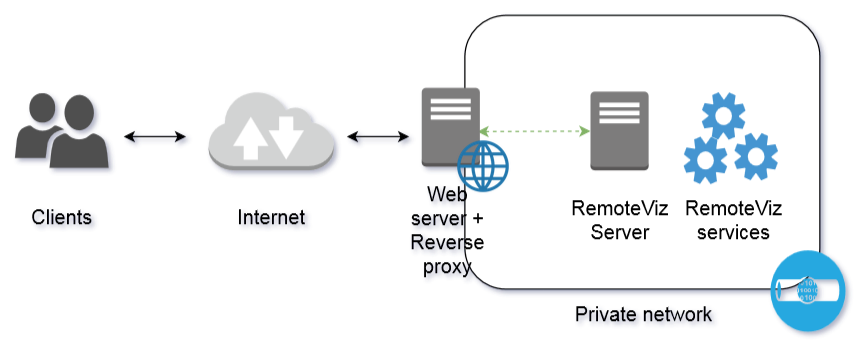Apache
[ReverseProxy]
RemoteViz and Apache reverse proxy
Summary
RemoteViz uses WebSocket protocol to make possible the communication between the client and the service. Without any web servers between the client and the RemoteViz service, a WebSocket connection can be established smoothly. However, in production environments, the web page requests are handled by a web server and only the web server port (port 80 by default) is open from the outside in order to guarantee security. To use the same port and domain for the HTTP requests and the Websocket requests, the websocket traffic has to be routed through the web server. This document explains how to configure Apache server as reverse proxy to handle web page requests and websocket traffic over the same port and domain.

Compatibility
- Apache server supports the module "mod_proxy_wstunnel" from the version 2.4.10. This module requires the service of "mod_proxy". It provides support for the tunneling of web socket connections to a backend websockets server.
Apache Installation
- Please refer to the Apache official documentation to install Apache HTTP Server:
For Microsoft Windows: http://httpd.apache.org/docs/current/platform/windows.html
For Unix systems: http://httpd.apache.org/docs/current/install.html
Apache Configuration
- In the next section, we consider that the Apache web server is bound to the public port 80 (non-SSL) or 443 (SSL) and the RemoteViz service is bound to the private port 8080 (behind a firewall). The "httpd.conf" file is used to configure Apache server. To proxy Websocket requests from your server, you have to enable the modules "mod_proxy_wstunnel" and "mod_proxy". To do this, add or uncomment the following lines:
LoadModule proxy_module modules/mod_proxy.so LoadModule proxy_wstunnel_module modules/mod_proxy_wstunnel.so
Then inside a "VirtualHost" block, add a "Location" block. This block describes how Websocket requests are handled. Here is an example of the configuration that is used to handle the WebSocket requests directed at "/RemoteViz".
Without Secure Sockets Layer (SSL) encryption:
<VirtualHost *:80>
# Replace "yourdomain" by your public domain name server (DNS)
ServerName yourdomain
DocumentRoot "${path}"
# Route websocket to the RemoteViz Service
<Location /RemoteViz>
# Replace "remoteviz_service_ip" by the RemoteViz service IP address
ProxyPass ws://remoteviz_service_ip:8080
ProxyPassReverse ws://remoteviz_service_ip:8080
</Location>
</VirtualHost>
With Secure Sockets Layer (SSL) encryption:
<VirtualHost *:443>
SSLEngine on
SSLProxyEngine on
# Set the path to the public certificate file
SSLCertificateFile "conf/ssl/ssl-cert.crt"
# Set the path to the private key file
SSLCertificateKeyFile "conf/ssl/ssl-private.key"
# Set the path to the Intermediate Certificate
SSLCertificateChainFile "conf/ssl/CA_Bundle.pem"
# Replace "yourdomain" by your public domain name server (DNS)
ServerName yourdomain
DocumentRoot "${path}"
# Route secure websocket to the RemoteViz Service
<Location /RemoteViz>
# Replace "remoteviz_service_ip" by the RemoteViz service IP address
ProxyPass wss://remoteviz_service_ip:8080
ProxyPassReverse wss://remoteviz_service_ip:8080
</Location>
</VirtualHost>
The apache websocket proxy module is based on URI. Each HTTP requests containing "/RemoteViz" in the URI will be considered as a Websocket connection and will be redirected to port 8080.
HTML Client Configuration
- The last step is the modification of the websocket connection address in the HTML client file. In the file index.html, replace the line:
theRenderArea.connectTo("ws://127.0.0.1:8080/RenderAreaName");
by the line for using non-SSL:
theRenderArea.connectTo("ws://yourdomain/RemoteViz/RenderAreaName");
or by the line for using SSL:
theRenderArea.connectTo("wss://yourdomain/RemoteViz/RenderAreaName");